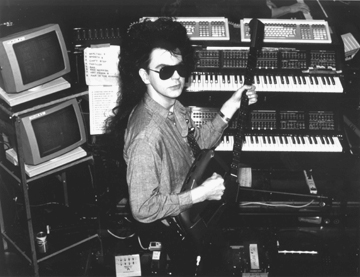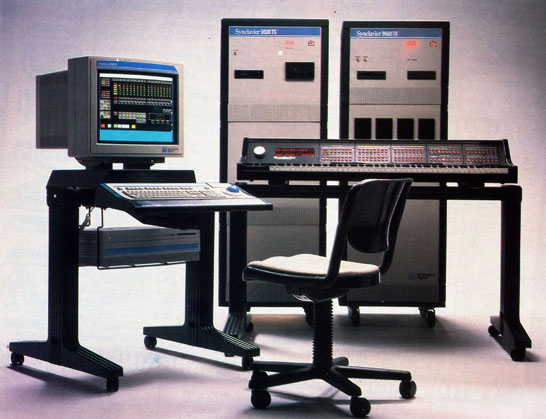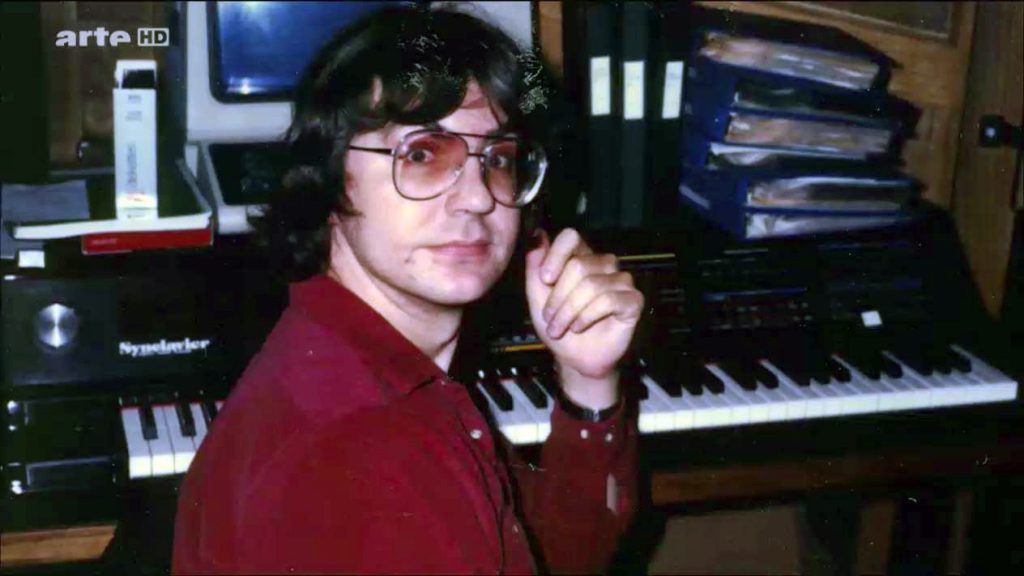
Many people are interested in my work with Michael Jackson and have requested that I share some of my experiences. I thought about this and decided to talk a bit about my music interaction with Michael Jackson. We will return to “Out of Your Head” in two months.
Throughout the 70’s, I had been playing in various bands and doing recording sessions playing guitar. I had always been trying to alter or extend the sounds of my electric guitar. I found that, for me, the sound of guitar was limited compared to the sounds I heard in my head. I was always looking for some way to get some kind of abstract sound out of my guitar. I was already very familiar with the Moog synthesizer. But since it was attached to a keyboard and I was a guitar player, my access to new sounds was limited. There were no reliable guitar controllers for synthesizers at that time (circa 1970).
A big shift in my music career began when I was first introduced to the Synclavier II at the Audio Engineering Society (AES) convention in May 1980. The Synclavier was originally developed as the “Dartmouth Digital Synthesizer” by Dartmouth College Professor Jon Appleton, in association with New England Digital Corp. (NED) co-founders Cameron W. Jones and Sydney A. Alonso. The Synclavier would become the pioneering prototype hardware and software system for all digital non-linear synthesis, polyphonic sampling, magnetic (hard-disk) recording and sequencing systems technology that is commonplace in all music and sound effects/design today.

When I heard the Synclavier II at AES, I was completely mesmerized by its sound quality. It had 32 voices. It also had what was called a digital memory recorder, essentially a built in 16 track, 15,000 note digital sequencer. The musician could control the parameters via the front panel or through a computer terminal. I could type notes and events into the Synclavier to create my compositions. It was not as easy as playing my guitar but I could interact with this system in a musical way.
I thought that if I had the Synclavier, I could play all my music myself without other musicians. Around this time period, I had become frustrated with the band concept because musicians were unreliable. I would put in lots of hours in rehearsal time and promotion just to have a band member quit because he needed to get a day job or he was not spending enough time with the wife, etc. The idea that I could compose all my music and perform it myself on the Synclavier was very appealing.
The Synclavier seemed like an answer to my musical dreams! I wanted one right away! That’s when I had an extreme reality check…this system was $40,000.00! I could barely afford my $500.00 month rent! It seemed I would have to make some real money to afford the Synclavier! My current lifestyle would need to be seriously upgraded to make a Synclavier purchase a reality.
I started calling many people who had a Synclavier or had access to one and tried to learn as much as I could about the machine. I probably was quite annoying since I was always asking questions but I was always treated courteously. These people were very generous with their time and I was given much help and information. One of these people was the west coast NED distributer, Denny Yeager.
I first tried to get a business loan. I went to many banks. I learned a lot about banking doing this. Every time I applied for a loan, I had to ask Denny to send the cost estimates. This began to be a routine. After being turned down by ALL the banks, I changed my strategy and tried to find a sponsor or investor. Again I had to ask Denny for the breakdowns for each time I did a business plan and submitted it to a potential investor. Meanwhile, I spent my last $80.00 on the Synclavier manual, which was the size of an LA phone book!
After two years of unsuccessfully trying to acquire the funds to buy a Synclavier and my last hope for an investor went south, Denny commented, “You really want a Synclavier don’t you?” I said “Of course!” Then he told me he had one sitting in his closet and that he would sell it to me on time as a personal loan. I was thrilled to say the least! He sent it back to NED to make sure everything was working properly and up to date. It arrived at my house in the summer of 1982!
I started using the Synclavier for music productions. I was then asked to talk to UCLA students about digital synthesis and I used the Synclavier as a teaching tool. I was also asked to do a local cable talk show about innovation and creativity. It was while I was doing this show that a representative of Warner Bros Records happened to tune in. He was impressed so he called me up and invited me over to Warner Bros for a meeting. At this meeting, he gave me an artist to produce. He also recommended an engineer, Paul Brown. Paul is now the number one producer for Smooth Jazz. We hit it off well and started a production company and began producing artists. The Synclavier was our main production tool. We had a sound that other producers and artists could not reproduce. The Synclavier was a good marketing tool! I was able to pay off the original loan to Denny with no problems and I started upgrading my Synclavier.
In 1983, sampling and a new keyboard were added to my system. For the next two years, I was doing various sessions with the Synclavier. I had branched off on my own as a producer and Synclavier programmer. It was in the summer of 1985 that I got a call from Michael Jackson. He had heard about me from the New England Digital company. Michael had a huge Synclavier system and he asked me if I would teach him how to use it. Apparently he had had many programmers operating his Synclavier but not being musicians, Michael couldn’t relate to them so he decided to learn it himself. I put together a nice learning program and schedule for Michael to learn the Synclavier. We finally scheduled a time where we could meet and begin my teaching. I went to his personal studio at his house on a Sunday morning. He introduced himself and was very hospitable and polite. I liked him right away. We sat down in front of the Synclavier and began his first lesson.
He told me “I don’t know anything about computers.” I said “no problem, first, you insert this floppy disk.” He said “time out” and said he did not know what a floppy disk was. I realized Michael barely knew how to operate a cassette recorder! His hands on with technology was very limited! So I got more simple and we continued. After three hours, I had taught Michael how to power up and boot up the Synclavier, call up his sound library and showed him how to call a sound down to the keyboard for him to play.
He said “That’s all I can take for today, can you come back tomorrow for a session?” I said “sure!” Little did I know that this would be the beginning of the most interesting four years of my life!
I came back the next day and we worked on one of Michael’s songs. He wanted me to come back everyday. He said to me “I want you to make unusual sounds.” I said “sure, no problem!” I like doing that all the time anyway! This was not work, this was fun! I began to think…if I want to continue to be here, I have to expand my job. I had realized that by having so many programmers and musicians using the Synclavier in the past, his sound library was in chaos. I thought that no matter if it is me or someone else that uses Michael’s Synclavier, the sound library had to be in some logical order that can be accessed easily. There were thousands and thousands of sounds on hard disks and computer storage tapes everywhere and none of them were organized in any way! I presented to Michael the problem and that I could organize his library for him. He said “sure!” So I began working longer hours. I was at his studio from about 10:00 am to about 1:00 am every day. This job ended up taking me six months, seventeen hours a day seven days a week! The year was 1986.
In the meantime, I was continuing to make “unusual sounds.” Unusual sounds are fun but they have no real meaning unless they are in some kind of context, so I would create grooves and various musical pieces that would demonstrate the possible uses for the sounds I was creating. When I was finished, I would run them off on a cassette tape and slide it under his bedroom door every night before I would go home. Many times, he would call my house at 2:00 am and would be all excited about some sounds or groove. I could hear the tape I had made blasting in the background! Michael likes to listen to music LOUD!
After a few weeks of working closely together, we both realized that our ability to communicate together was a bit unique. We just both understood each other about musical ideas and grooves. We noticed that words were used less often and we just “knew” what we were feeling or thinking. It quickly got to the point where Michael would say to me “make me a sound that makes me do this”…and he would do a dance move. I got it right away…and I could make him the sound that he was feeling. I have never worked with anyone else where we had this kind of musical rapport.

After about six months working with Michael everyday on various songs, sound design and library work, I got the word that Michael was soon to start his next album with Quincy Jones. We had lots of songs demoed. I was wondering if I was going to be working with Michael and Quincy or if my fun job would finally close.
One day, I was working in Michael’s studio when his secretary came in and announced to me and the engineer that Michael was having guests that evening and we could all go home at 5:00 pm. I thought ok cool. I worked for a few hours and as it was near 5:00, Michael’s secretary came in and said that Michael said I can stay. I really did not think much of it. Everyone left and I was alone making music on the Synclavier. It was dark outside when I heard voices of people entering the studio in the next room. Suddenly the door opened and in walked Michael with Diana Ross and an entourage of people. I was very surprised! Michael was giving Diana a tour of his studio. He then introduced me to Diana and told her what I did and showed her the Synclavier. Clearly he was showing off! Then he continued the tour and they walked out. This kind of experience would become normal over the next four years.

I was working one afternoon when Michael told me that he was going to start the new album very soon and that Bruce Sweden, his engineer for the Thriller album, was coming for a visit. Bruce was going to be the engineer for the new album so he was visiting Michael on a kind of combined social PR visit. Bruce came in the studio and was very friendly. Michael introduced me and told him what I did. Bruce acknowledged but was very focused on what he wanted to convey to Michael. He had just finished the sound track for a movie called “Running Scared” starring Gregory Hines and Billy Crystal. Bruce said that this was the first time he had done a whole project digitally and it sounded great! He was telling Michael all the details. Bruce then said that it was also the first time he had worked with the Synclavier and how amazing it was to be able to create sounds so fast and move tracks easily, etc. He said that the Synclavier operator was really good and a very nice person and that they had become friends. I knew who most of the Synclavier operators were, but not all personally. I knew the operator Bruce was talking about by name only.
I thought, wow, Bruce is promoting his Synclavier guy. It looks like I will be out of a job soon. I was a bit depressed but I had a good time the past six months and it had been a great experience. I was pretty sure I would not be working on the new album.
Everyone in Michael’s camp knew in a week, all the work at Michael’s studio would shift to WestLake Studios where the new album would be recorded. No one said anything to me. I did not know what would become of me. I just kept working as usual. Then the day before the work was to begin at Westlake, Michael’s secretary came in the studio and said to me that Michael wanted me to work on the album and to move the Synclavier to Westlake. Wow! Michael wanted me to work on the album! I was in! To say the least, I was thrilled!

Next month, I will continue my Synclavier and Michael Jackson story:
The making of the “Bad” album and the “Bad” world tour.
See you next month here at the Event Horizon!
You can check out my various activities at these links:
http://transformation.ishwish.net
http://currelleffect.ishwish.net
http://www.ishwish.net
http://www.audiocybernetics.com
http://ishwish.blog131.fc2.com
http://magnatune.com/artists/ishwish
http://www.plenumvoid.com
Or…just type my name Christopher Currell into your browser.
Current Headphone System:
- Woo Audio WES amplifier with all available options
- Headamp Blue Hawaii with ALPS RK50
- Two Stax SR-009 electrostatic headphones
- Antelope Audio Zodiac+mastering DAC with Voltikus PSU
- PS Audio PerfectWave P3 Power Plant
- Wireworld USB cable and custom audio cable by Woo Audio
- MacMini audio server with iPad wireless interface.














Reply
Reply
Reply
Reply
Reply
Reply
Reply
Reply
Reply
Reply
Want to join discussion?
Feel free to contribute!